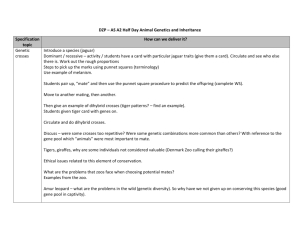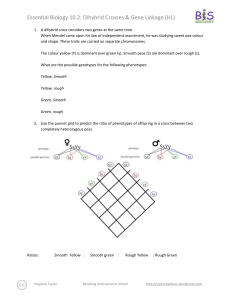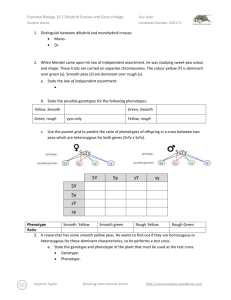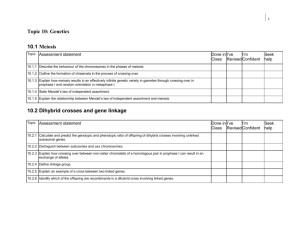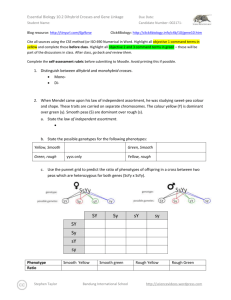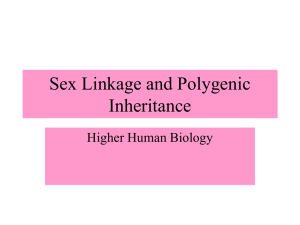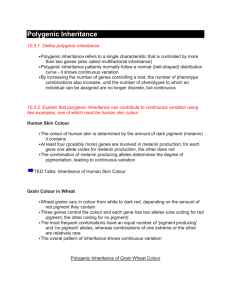10.2-10.3 - biology4friends
advertisement
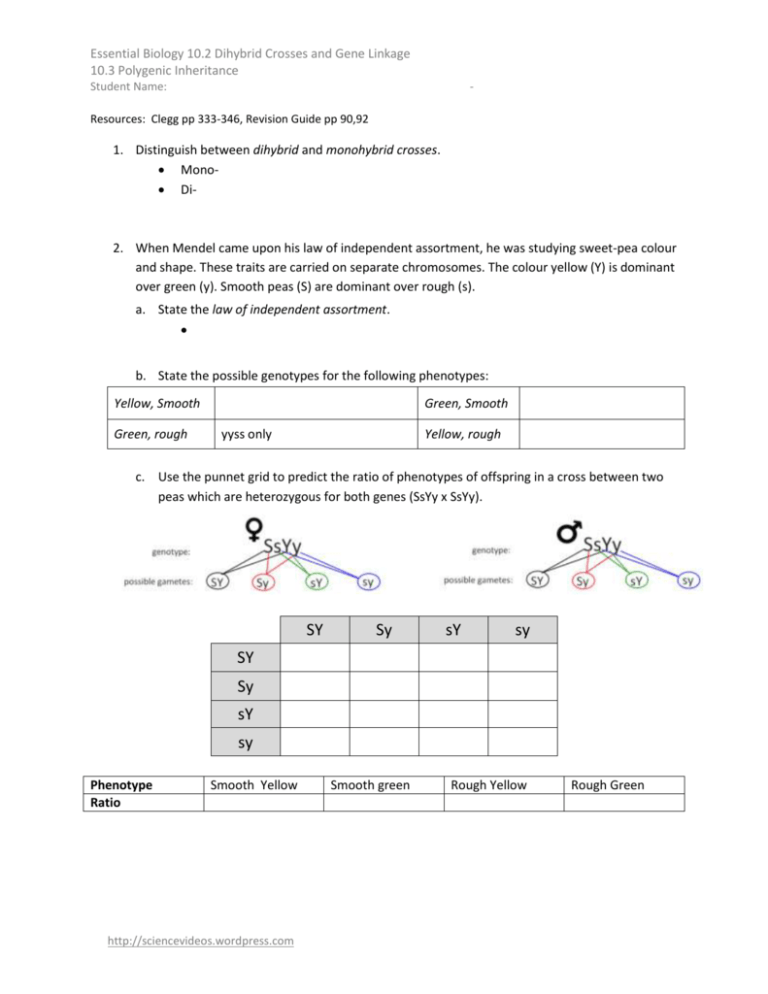
Essential Biology 10.2 Dihybrid Crosses and Gene Linkage 10.3 Polygenic Inheritance Student Name: - Resources: Clegg pp 333-346, Revision Guide pp 90,92 1. Distinguish between dihybrid and monohybrid crosses. Mono Di- 2. When Mendel came upon his law of independent assortment, he was studying sweet-pea colour and shape. These traits are carried on separate chromosomes. The colour yellow (Y) is dominant over green (y). Smooth peas (S) are dominant over rough (s). a. State the law of independent assortment. b. State the possible genotypes for the following phenotypes: Yellow, Smooth Green, rough Green, Smooth yyss only Yellow, rough c. Use the punnet grid to predict the ratio of phenotypes of offspring in a cross between two peas which are heterozygous for both genes (SsYy x SsYy). SY i. Sy sY sy SY Sy sY sy Phenotype Ratio Smooth Yellow http://sciencevideos.wordpress.com Smooth green Rough Yellow Rough Green Essential Biology 10.2 Dihybrid Crosses and Gene Linkage 10.3 Polygenic Inheritance Student Name: - 3. A researcher has some smooth yellow peas. He wants to find out if they are homozygous or heterozygous for these dominant characteristics, so he performs a test cross. a. State the genotype and phenotype of the plant that must be used as the test cross. Genotype: Phenotype: b. Complete a series of punnet grids for this series of test crosses. Deduce the phenotype ratios expected in the following crosses. i. Heterozygous for both colour and shape? ii. Phenotype Ratio ii. Homozygous for both colour and shape. iii. Phenotype Ratio iii. Heterozygous for colour, homozygous for shape. iv. Phenotype Ratio iv. Homozygous for colour, heterozygous for shape. Phenotype Ratio http://sciencevideos.wordpress.com Essential Biology 10.2 Dihybrid Crosses and Gene Linkage 10.3 Polygenic Inheritance Student Name: - c. In the cross, the student found 120 yellow-smooth and 124 green-smooth. Deduce the most likely genotype for the unknown pea. Explain your answer. Genotype: Explanation: d. State the statistical test used to test for significance of difference between observed and expected outcomes. 4. Some genes affect the expression of others. a. Define gene interaction. b. Identify the phenotype ratios for a cross between two ‘agouti’ (brown) mice, where: Gene C determines if colour is present: C = coat has colour If colour is present, then: A = agouti (brown) The mice are both heterozygous for both genes. CA CA Phenotype Ratio c. Explain why the phenotype ratio is not 9:3:3:1. http://sciencevideos.wordpress.com c = albino a = black Essential Biology 10.2 Dihybrid Crosses and Gene Linkage 10.3 Polygenic Inheritance Student Name: - 5. Mendel’s law of independent assortment makes the assumption that genes for a pair or group of traits are being carried on separate chromosomes, and therefore the presence of one allele in a gamete is not connected to the presence of another. However, with hundreds of genes per chromosome, it is likely that some genes will be physically linked and therefore alleles will be inherited together. a. Define linkage groups. b. State the consequence of gene linkage in terms of the movement of alleles in anaphase I. Linkage groups will not… c. State two plant examples of gene linkage. The notation shows genes of Zea mays (corn). It is described as “heterozygous at both loci”. These are both traits related to the corn kernels. Key: C = colour, c = no colour; W = waxy, w = no wax. Draw some other possible combinations of these linked genes: Homozygous dominant at both loci Homozygous recessive at locus 1. (you decide) – describe it http://sciencevideos.wordpress.com Essential Biology 10.2 Dihybrid Crosses and Gene Linkage 10.3 Polygenic Inheritance Student Name: - d. Complete a punnet grid to show the possible phenotypes produced by a cross between the corn that is heterozygous at both loci. Use correct notations and show your working. Phenotype Ratio e. List the combinations of alleles which are not possible in the cross above (unless recombination takes place at Prophase I). f. A small number of kernels which are coloured but not waxy appear in the offspring. Explain the process that must have occurred for this to be the case. Process: g. State the stage of meiosis during which crossing over and exchange of alleles can occur. http://sciencevideos.wordpress.com Essential Biology 10.2 Dihybrid Crosses and Gene Linkage 10.3 Polygenic Inheritance Student Name: - h. Complete the punnet grid below: P p l p l L p l PpLl no recombination with crossing over (recombinants) 6. The term linkage is used in various ways in genetics. a. Distinguish between autosomes and sex chromosomes. b. Distinguish between gene linkage and sex linkage. http://sciencevideos.wordpress.com Essential Biology 10.2 Dihybrid Crosses and Gene Linkage 10.3 Polygenic Inheritance Student Name: - Resources: Clegg pp. 343-6, Revision Guide, pp 91. . 7. Define polygenic inheritance. 8. Distinguish between polygenic inheritance and multiple alleles. 9. List one human and one plant example of polygenic inheritance. 10. Define contributing allele. 11. Polygenic inheritance gives rise to continuous variation within a population. Explain what this means, using skin colour as an example. 12. Assume that two genes (A and B) are responsible for inheritance of skin colour, with two alleles each and that they are unlinked. The dominant alleles code for melanin production. a. Calculate the number of possible genotypes. http://sciencevideos.wordpress.com Essential Biology 10.2 Dihybrid Crosses and Gene Linkage 10.3 Polygenic Inheritance Student Name: - b. Apply the possible genotypes to the range of phenotypes below: aabb Aabb c. Explain why the phenotypes show a normal distribution. 13. Using a punnet grid, explain why it is possible for children to have skin which is darker or lighter than both parents. Mother genotype: Father genotype: AB i. AB Ab aB ab http://sciencevideos.wordpress.com Ab aB ab
